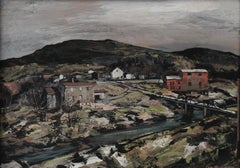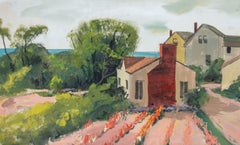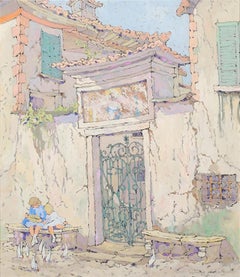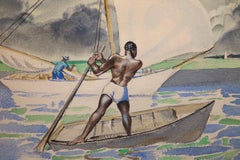Carl Frederick Gaertner Art
American, 1898-1898
Carl Gaertner was one of the greatest painters to emerge from the Cleveland School. Born in Cleveland on April 18, 1898, he graduated from East Technical high school in 1918 and attended Western Reserve College. From 1920 to 1923 he studied at the Cleveland School of Art (now the Cleveland Institute of Art) with Henry Keller. In 1922, he entered his first May Show at the Cleveland Museum of Art and was awarded a prize for an industrial oil painting. From 1925 until 1952, he was known as a pillar of the Cleveland School and one of their most prestigious painting instructors.
Gaertner’s subject matter was always drawn from the world around him. Early in his career, he focused on Cleveland and its environs. This interest never left him, but as he matured, his choice of subjects broadened. He painted watercolors and oils of Bermuda in the mid 1920s and began making frequent trips to Provincetown beginning in the 1920’s. Like other Cleveland artists, he culled inspiration from travels within the United States, notably trips through Pittsburgh’s dramatic industrial landscapes and Cambridge Springs in Pennsylvania, to the mountains of West Virginia, and to Cape Cod. From the mid 1940s until his death, he also produced paintings based on sketches made during train rides to visit galleries in New York City.
At the time of his premature death in 1952, Carl Gaertner enjoyed a considerable reputation as a master of American Scene painting. By the 1940s, Gaertner was represented by the venerable Macbeth Gallery in New York City and his paintings were exhibited in shows throughout the United States. In 1944 and 1952, Gaertner received the National Academy of Design’s highest award for individual work in a group exhibition, and his work was exhibited in the Cleveland Museum of Art’s May Show for 27 years. Gaertner’s works are in the collections of many prestigious institutions, including the Cleveland Museum of Art, the Metropolitan Museum of Art, the Chicago Institute and the Whitney Museum of American Art.
The reflective eye of Gaertner chronicled three decades of Cleveland and the landscapes of the Midwest and its people. It is all there: the growing might of industrial Cleveland; the mass-produced promise of the assembly line, giving way to a dawning awareness of lost freedom and the surrender of individuality; the love affair of Americans with nature and the ideals of Thoreau and Whitman and Frost; and the conflict between that love affair and industrial promise.
Gaertner was just achieving national acclaim at the time of his early death at the age of 54. A resurgence of enthusiasm for Gaertner and his works began in the 1970’s and has steadily increased and incrementally boosted the value of his work, with a fine rare example, “The Popcorn Man” reaching $250,000 at auction.(Biography provided by WOLFS)
to
2
2
2
1
1
Overall Height
to
Overall Width
to
1
1
1
1
1
1
2
1
1
2
6,857
3,171
2,516
1,217
2
2
2
Artist: Carl Frederick Gaertner
Rock Creek, Mid-century Ohio Landscape Painting, Cleveland School
By Carl Frederick Gaertner
Located in Beachwood, OH
Carl Frederick Gaertner (American, 1898-1952)
Rock Creek, 1950
Gouache on artist board
Signed and dated 1950 lower right/inscribed verso
14 x 19.5 inches
20...
Category
1950s American Realist Carl Frederick Gaertner Art
Materials
Gouache
Flower Garden, Cape Cod, Mid-Century Cleveland School Painting
By Carl Frederick Gaertner
Located in Beachwood, OH
Carl Frederick Gaertner (American, 1898-1952)
Flower Garden, Cape Cod, c. 1940s
Gouache on illustration board
17.5 x 29 inches
27 x 39 inches, as framed
Carl Gaertner was one of the greatest painters to emerge from the Cleveland School...
Category
1940s American Realist Carl Frederick Gaertner Art
Materials
Gouache
Related Items
The Gateway
By Eleanor Parke Custis
Located in New York, NY
Signed (lower right): ELEANOR PARKE CUSTIS
Category
20th Century American Realist Carl Frederick Gaertner Art
Materials
Paper, Gouache
Fishermen, Bahamas (North Carolina artist)
By Frank Stanley Herring
Located in Wilton Manors, FL
Beautiful ca. 1935 painting by American artist, Frank Stanley Herring (1894-1966). Watercolor on heavy rag handmade paper measures 14.5 x 19 inches, 23 x 28 inches in original vintag...
Category
1930s American Realist Carl Frederick Gaertner Art
Materials
Handmade Paper, Watercolor
St, Louis River Mural Study American Scene Social Realism Mid 20th Century WPA
By Jo Cain
Located in New York, NY
St, Louis River Mural Study American Scene Social Realism Mid 20th Century WPA
Jo Cain (1904-2003)
The Drama of the St. Louis Great River
23 1/4 x 25 ½ inches
Gouache on board c. 19...
Category
1930s American Realist Carl Frederick Gaertner Art
Materials
Gouache, Board
UNION SQUARE Depression Era Oil Painting WPA Realism American Scene Realism NYC
By Jo Cain
Located in New York, NY
UNION SQUARE Depression Era Oil Painting WPA Realism American Scene Realism NYC
Jo Cain (1904 – 2003) "Union Square," 24 x 36 inches. Oil on canvas, c.1940s, ...
Category
1940s American Realist Carl Frederick Gaertner Art
Materials
Canvas, Oil
"Pacific" Oil Painting
By Gordon Brown
Located in Denver, CO
Gordon Brown's (US based) "Pacific" is an oil painting that depicts rolling waves crashing against a rocky shore.
Bio/artist statement:
"My paintings are all about light and mood,"...
Category
2010s American Realist Carl Frederick Gaertner Art
Materials
Oil
"Aspen Light" Oil Painting
By Gordon Brown
Located in Denver, CO
Gordon Brown's (US based) "Aspen Light" is an oil painting that depicts dense cluster of aspens turning with colorful yellow leaves whose thick canopy blo...
Category
2010s American Realist Carl Frederick Gaertner Art
Materials
Oil
Circus Wagons
By Millard Sheets
Located in Los Angeles, CA
This watercolor is part of our exhibition America Coast to Coast: Artists of the 1930s
Circus Wagons, 1927, watercolor on paper, signed and dated lower left, 10 x19 ¾ inches (sight), provenance includes Stary-Sheets Art Gallery (Gualala, CA); J. Ralph & Louis Stone Foundation; presented in a newer metal frame behind glazing
About the Painting
Millard Sheets was only twenty years old and in his third year of studies at the Chouinard Art Institute when he painted Circus Wagons. Despite his youth, Sheets was already an accomplished artist who had publicly exhibited his work and won prestigious prizes. Within several years, he would have his first solo exhibition at one of Los Angeles’ premiere galleries and become a painting instructor at his alma mater. In Circus Wagons we already see Sheets deft handling of the watercolor medium and his interest in the California Scene. In this case, Sheets captures a back lot view of a traveling circus, a subject he sometimes returned to, including in a color screen print in the collection of the National Gallery. Sheets made a career by painting what he knew and observed firsthand. This approach allowed Sheets to capture with authenticity the details of each narrative. Even with a narrowly limited palette and an economy of brushstrokes, Sheets effectively depicts the southern California scene with its strong and mysterious shadows, as well as the workers and circus animals. Seen through the hindsight of his six-decade long career, Circus Wagons offers a fascinating insight into the early development of California Scene painting which would by the mid-1930s become the best recognized style on the West Coast.
About the Artist
Millard Sheets was the dean of California watercolorists. His list of accomplishments is so extensive that his entry in Who was Who in American Art is over forty lines. Born in Pomona, California, Sheets became a painter at an early age, winning a prize at the Los Angeles County Fair in 1918. By the mid to late-1920s, Sheets became a regular at art exhibitions in the western part of the United States, winning several additional prizes before he reached the age of twenty-five. Sheets studied at the prestigious Chouinard Art Institute from 1925 through 1929 with Frank Tolles Chamberlin and Clarence Hinkle and had his first solo show with Los Angeles’ Dalzell Hatfield Gallery in 1929. During the 1930s, Sheets was invited to exhibit at almost every major American Museum and in many ways, his work came to represent the California watercolor school...
Category
1920s American Realist Carl Frederick Gaertner Art
Materials
Watercolor
Pulp Magazine Marine Combat Scene Shoot Out in Blue Noir
Located in Miami, FL
What makes this work important?
It's not that it's a commissioned artwork for a men's 60s pulp adventure magazine depicting the instant a soldier is shot. The big point of the painting is how brilliantly the formal elements are thought out, designed, and executed. John McDermott tells a story using a complex figural composition in an unexpected wide-angle vision. The work is as abstract as it is representation. His use of light is significant because it creates a high-contrast two-color style that bears the mark of its creator. This is a work done by a master artist/illustrator without peers compared to artists living today. If the contemporary art world gave awards for draftsmanship, painting technique, and graphic design .... John McDermott would win the highest accolades.
Initialed lower left - unframed
John McDermott (August 30, 1919 – April 20, 1977), also known under the pen names J.M. Ryan and Mariner, was an American illustrator and author noted for action and adventure illustrations.[1] McDermott worked as an in-between and effects animator for Walt Disney Studios and as a US Marine combat artist,before establishing himself as a cover illustrator for 1950s paperbacks and pulp magazines such as Argosy, American Weekly, and Outdoor Life. Under his J.M. Ryan pen name, he wrote the novels The Rat Factory (1971), a derogatory satire of Walt Disney and the Disney studio; Brooks Wilson Ltd (1967), on which the 1970 film Loving was based; and Mother's Day (1969) about Ma Barker. Under his own name, he novelized director-writer Bo Widerberg's screenplay for the 1971 film Joe Hill, which would be his final published book.
Early life
John Richard McDermott was born 30 August 1919 in Pueblo, Colorado, the younger of two sons of Henry McDermott, an oil broker. McDermott was a young child when his father committed suicide.[4] The family eventually moved to Los Angeles where McDermott's mother, Hazel, worked in a beauty parlor. He graduated from Hollywood High School in 1936. Although he had had no formal art education, he took a job as an artist at Walt Disney Animation Studios.
Career
Disney
At Disney, McDermott worked as an in-betweener and effects animator on Brave Little Tailor, Pinocchio, The Reluctant Dragon and Fantasia. His experiences while working at Disney, particularly during the time of the 1941 Disney animators' strike, would later become the basis for his 1969 satirical novel The Rat Factory. McDermott left Disney to fight with US forces during World War II.
US Marines
McDermott World War II sketch titled "Buddy is Wounded"
On September 29, 1942, McDermott enlisted with the US Marine Corps. He served as a "pistol and palette" combat artist assigned to the map-making section. As a sergeant with the III Amphibious Corps, McDermott was involved in battles in the South Pacific theater of war, documenting the Guam, Okinawa and the Guadalcanal Campaigns. McDermott considered his wartime years to be his art education.
"In the Marines, as a combat artist, I traveled with the troops and for three years got all the drawing opportunity anyone could want. My work changed enormously during this time and I’m sure it was due to constant drawing, every single day, from life, just putting down what I saw around me. In a few instances it was a dangerous kind of scholarship."
According to the Marine Corps history journal Fortitudine, McDermott was so prolific that his contemporary style pen-and-ink sketches became easily recognizable to both Marines, from published work in Leatherneck Magazine, and civilians, from glossy copies supplied by the Marine Corps to the nation's press.His wartime art appears in World War II history books and is displayed at the Pentagon and the National Museum of the Marine Corps.
Illustration
Following the end of World War II, McDermott moved from California to New York City to work as a freelance illustrator. McDermott made his reputation drawing modern action, war and adventure scenes. His work adorned the covers and inside story pages of popular pulp magazines of the 1950s such as Argosy, Adventure, Blue Book, Outdoor Life and American Weekly.
McDermott's illustrations appeared on numerous covers of 1950s paperback novels published by Dell, Fawcett Gold Medal, Bantam Mystery and others. His action graphics were geared toward thriller and detective genres, such as Donald Hamilton's Matt Helm books Murderers' Row and The Betrayers. He also created covers for science fiction comic titles such as Voyage to the Deep[citation needed] and horror-themed paperbacks such as the classic 1955 science fiction novel The Body Snatchers...
Category
1960s American Realist Carl Frederick Gaertner Art
Materials
Illustration Board, Gouache
H 18.6 in W 20.2 in D 1 in
1840 rare watercolor, Native American encampment, Western Indian Unknown artist
Located in Buffalo, NY
A rare mid 19th Century watercolor depicting Native Americans approaching a fort.
The subjects appear to be from a Northern Plains Tribes, and arre approaching a palisades style f...
Category
1840s American Realist Carl Frederick Gaertner Art
Materials
Paper, Watercolor, Gouache
Street Scene WPA American Scene Mid-20th Century Modern Coin Tower California SF
By Victor Michail Arnautoff
Located in New York, NY
Street Scene WPA American Scene Mid-20th Century Modern Coin Tower California SF
Victor Arnautofff (1896 – 1979)
City Street
12 x 14 inches
Oil on board, c. 1930s
Signed lower left
BIO
Born in the Ukraine of Russia, Victor Arnautoff became one of the most influential muralists in San Francisco in the 1930s and worked for the Federal Arts Project, WPA, in the expressive, social protest...
Category
1930s American Realist Carl Frederick Gaertner Art
Materials
Oil, Board
"Chambers" Oil Painting
By Mark Harrison
Located in Denver, CO
Mark Harrison's (UK based) "Chambers" is an oil painting that depicts an arid landscape with clouds and a small unassuming building.
I have been interested in painting skies for a ...
Category
2010s American Realist Carl Frederick Gaertner Art
Materials
Oil, Linen
Knight’s Lodging
Located in Los Angeles, CA
This painting is part of our exhibition American Coast to Coast: Artists of the 1930s
Knight’s Lodging, 1941, oil on canvas panel, signed and dated lower left, 16 x 20 inches, exhi...
Category
1940s American Realist Carl Frederick Gaertner Art
Materials
Oil
Carl Frederick Gaertner art for sale on 1stDibs.
Find a wide variety of authentic Carl Frederick Gaertner art available for sale on 1stDibs. You can also browse by medium to find art by Carl Frederick Gaertner in gouache, paint, watercolor and more. Not every interior allows for large Carl Frederick Gaertner art, so small editions measuring 26 inches across are available. Customers who are interested in this artist might also find the work of Cecil Crosley Bell, Fletcher Martin, and Alex Roulette. Carl Frederick Gaertner art prices can differ depending upon medium, time period and other attributes. On 1stDibs, the price for these items starts at $5,280 and tops out at $17,050, while the average work can sell for $11,165.



